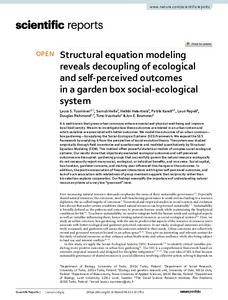Structural equation modeling reveals decoupling of ecological and self-perceived outcomes in a garden box social-ecological system
Tuominen Laura S.; Helle Samuli; Helanterä Heikki; Karell Patrik; Rapeli Lauri; Richmond Douglas; Vuorisalo Timo; Brommer Jon E.
https://urn.fi/URN:NBN:fi-fe2022081154647
Tiivistelmä
It is well known that green urban commons enhance mental and physical well-being and improve local biodiversity. We aim to investigate how these outcomes are related in an urban system and which variables are associated with better outcomes. We model the outcomes of an urban common—box gardening—by applying the Social-Ecological Systems (SES) framework. We expand the SES framework by analyzing it from the perspective of social evolution theory. The system was studied empirically through field inventories and questionnaires and modeled quantitatively by Structural Equation Modeling (SEM). This method offers powerful statistical models of complex social-ecological systems. Our results show that objectively evaluated ecological outcomes and self-perceived outcomes are decoupled: gardening groups that successfully govern the natural resource ecologically do not necessarily report many social, ecological, or individual benefits, and vice versa. Social capital, box location, gardener concerns, and starting year influenced the changes in the outcomes. In addition, the positive association of frequent interactions with higher self-perceived outcomes, and lack of such association with relatedness of group members suggests that reciprocity rather than kin selection explains cooperation. Our findings exemplify the importance of understanding natural resource systems at a very low “grassroot” level.
Kokoelmat
- Rinnakkaistallenteet [27094]
